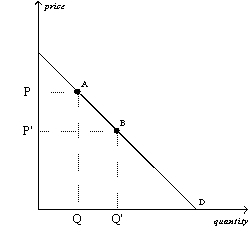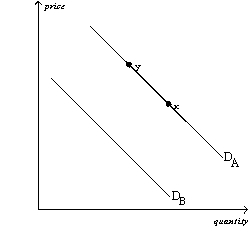A) competitive market.
B) monopoly market.
C) oligopoly market.
D) monopolistically competitive market.
F) None of the above
Correct Answer

verified
Correct Answer
verified
Multiple Choice
A supply schedule is a table that shows the relationship between
A) price and quantity supplied.
B) input costs and quantity supplied.
C) quantity demanded and quantity supplied.
D) profit and quantity supplied.
F) A) and D)
Correct Answer

verified
Correct Answer
verified
Multiple Choice
In competitive markets,
A) firms produce identical products.
B) no individual buyer can influence the market price.
C) no individual seller can influence the market price.
D) All of the above are correct.
F) A) and D)
Correct Answer

verified
Correct Answer
verified
True/False
A decrease in the price of pizza will shift the supply curve for pizza to the left.
B) False
Correct Answer

verified
Correct Answer
verified
Multiple Choice
Figure 4-1  -"Other things equal,when the price of a good rises,the quantity demanded of the good falls,and when the price falls,the quantity demanded rises." This relationship between price and quantity demanded
-"Other things equal,when the price of a good rises,the quantity demanded of the good falls,and when the price falls,the quantity demanded rises." This relationship between price and quantity demanded
A) applies to most goods in the economy.
B) is represented by a downward-sloping demand curve.
C) is referred to as the law of demand.
D) All of the above are correct.
F) B) and C)
Correct Answer

verified
Correct Answer
verified
Multiple Choice
Which of the following is not a characteristic of a perfectly competitive market?
A) Different sellers sell identical products.
B) There are many sellers.
C) Sellers must accept the price the market determines.
D) All of the above are characteristics of a perfectly competitive market.
F) C) and D)
Correct Answer

verified
Correct Answer
verified
Multiple Choice
An example of a perfectly competitive market would be the market for
A) tennis racquets.
B) pizza.
C) garbage collection.
D) wheat.
F) A) and B)
Correct Answer

verified
Correct Answer
verified
Multiple Choice
Suppose the incomes of buyers in a market for a particular normal good decrease and there is also a reduction in input prices.What would we expect to occur in this market?
A) Equilibrium price would decrease,but the impact on equilibrium quantity would be ambiguous.
B) Equilibrium price would increase,but the impact on equilibrium quantity would be ambiguous.
C) Equilibrium quantity would decrease,but the impact on equilibrium price would be ambiguous.
D) Equilibrium quantity would increase,but the impact on equilibrium price would be ambiguous.
F) A) and C)
Correct Answer

verified
Correct Answer
verified
Multiple Choice
Figure 4-17  -Refer to Figure 4-17.If the price is $10,then there would be a
-Refer to Figure 4-17.If the price is $10,then there would be a
A) shortage of 400 units,and price would rise.
B) surplus of 400 units,and price would rise.
C) shortage of 600 units,and price would rise.
D) surplus of 600 units,and price would rise.
F) B) and C)
Correct Answer

verified
Correct Answer
verified
Multiple Choice
Figure 4-19
The diagram below pertains to the demand for turkey in the United States.  -Refer to Figure 4-19.All else equal,a decrease in the price of the grain fed to turkeys would cause a move from
-Refer to Figure 4-19.All else equal,a decrease in the price of the grain fed to turkeys would cause a move from
A) DA to DB.
B) DB to DA.
C) x to y.
D) y to x.
F) A) and D)
Correct Answer

verified
Correct Answer
verified
Multiple Choice
A movement along the demand curve might be caused by a change in
A) income.
B) the prices of substitutes or complements.
C) expectations about future prices.
D) the price of the good or service that is being demanded.
F) A) and B)
Correct Answer

verified
Correct Answer
verified
Multiple Choice
Table 4-2
 -Refer to Table 4-2.If these are the only four buyers in the market,then the market quantity demanded at a price of $8 is
-Refer to Table 4-2.If these are the only four buyers in the market,then the market quantity demanded at a price of $8 is
A) 4 units.
B) 6 units.
C) 24 units.
D) 32 units.
F) None of the above
Correct Answer

verified
Correct Answer
verified
Multiple Choice
Table 4-5
 -Refer to Table 4-5.If these are the only four sellers in the market,then when the price decreases from $10 to $8,the market quantity supplied decreases by
-Refer to Table 4-5.If these are the only four sellers in the market,then when the price decreases from $10 to $8,the market quantity supplied decreases by
A) 2.5 units.
B) 4 units.
C) 10 units.
D) 50 units.
F) B) and C)
Correct Answer

verified
Correct Answer
verified
Multiple Choice
Figure 4-22
 -Refer to Figure 4-22.Which of the four panels represents the market for cars as a result of the adoption of new technology on assembly lines?
-Refer to Figure 4-22.Which of the four panels represents the market for cars as a result of the adoption of new technology on assembly lines?
A) Panel (a)
B) Panel (b)
C) Panel (c)
D) Panel (d)
F) All of the above
Correct Answer

verified
Correct Answer
verified
True/False
Most studies have found that tobacco and marijuana are complements rather than substitutes.
B) False
Correct Answer

verified
Correct Answer
verified
Multiple Choice
If a increase in income decreases the demand for a good,then the good is a(n)
A) substitute good.
B) complementary good.
C) normal good.
D) inferior good.
F) None of the above
Correct Answer

verified
Correct Answer
verified
True/False
The actions of buyers and sellers naturally move markets toward equilibrium.
B) False
Correct Answer

verified
Correct Answer
verified
Multiple Choice
Suppose that demand for a good decreases and,at the same time,supply of the good decreases.What would happen in the market for the good?
A) Equilibrium price would decrease,but the impact on equilibrium quantity would be ambiguous.
B) Equilibrium price would increase,but the impact on equilibrium quantity would be ambiguous.
C) Equilibrium quantity would decrease,but the impact on equilibrium price would be ambiguous.
D) Equilibrium quantity would increase,but the impact on equilibrium price would be ambiguous.
F) All of the above
Correct Answer

verified
Correct Answer
verified
Multiple Choice
Which of the following events must cause equilibrium price to fall?
A) demand increases and supply decreases
B) demand and supply both decrease
C) demand decreases and supply increases
D) demand and supply both increase
F) None of the above
Correct Answer

verified
Correct Answer
verified
Multiple Choice
A downward-sloping demand curve illustrates
A) that demand decreases over time.
B) that prices fall over time.
C) the relationship between income and quantity demanded.
D) the law of demand.
F) B) and D)
Correct Answer

verified
Correct Answer
verified
Showing 541 - 560 of 606
Related Exams